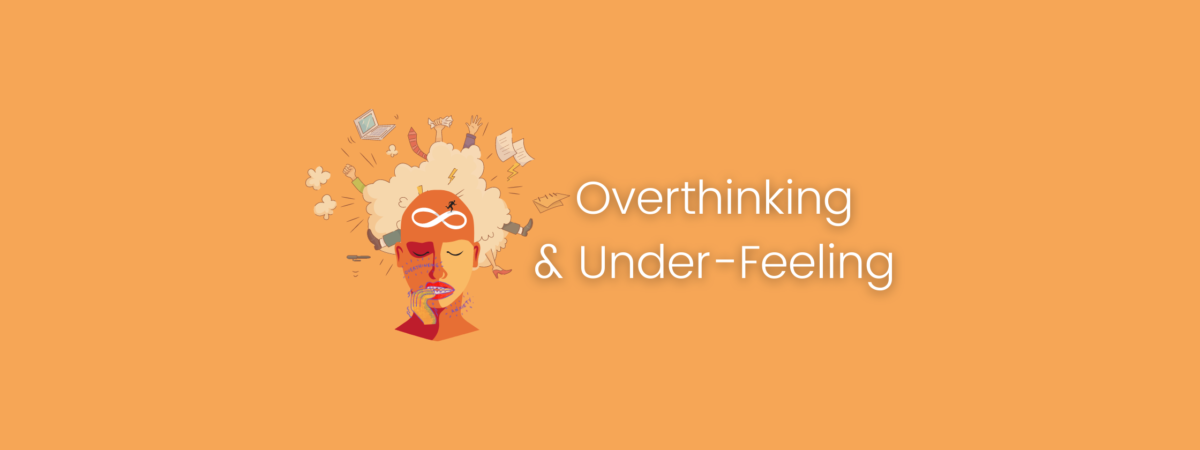Want to listen to this article instead?
When your mind goes into hyperdrive, dissecting a situation, it is your mind’s way of…
1) Trying to protect parts of you that have been hurt before
2) Attempting to control the outcome by finding the best possible solution
3) Avoiding feeling what is actually happening within you and your body
Overthinking might feel very productive in the moment yet it rarely results in a creative solution.
When perceived fear triggers your sympathetic nervous system it engages what is referred to as the fight or flight response. Overthinking is a symptom of fear and can become a trap.
Your mind flows through every part of your body and becomes one mouthpiece for beliefs, thoughts, and feelings. When you over-think you also under-feel. Emotions can get trapped inside the body causing a person to experience tiredness, exhaustion, have headaches or migraines, digestive issues, feel overall achy. And guess what… this feedback gets recycled back to your brain again to reinforce the fear trigger.
If you’re caught up in this negative loop, here are several things you can do to help break out of that cycle…

Exercise
Moving your body to break a sweat and increase your heart rate for even five minutes begins the process for breaking down stress hormones and sends messages to the brain that this fight or flight response has done it’s job. In addition, exercise can also increase endorphins which are the feel-good hormones which makes this option a win-win.
Breathe
When this flight or flight response is triggered remember to breathe. Sounds simple yet if you’re in the middle of a meeting or class, or a quick burst of exercise is not an option, this will help you send signals to your brain that you are safe and can relax. Breathwork is very powerful and is used for many things including inducing a trance state, releasing emotions stuck in the body, and of course relaxation. As with anything, the more you practice breathing exercises, the better the result and quicker they can work for you.


Come Back To This Moment
This helps to disrupt loop of a mind-fullness and bring it into mindfulness. Again, this can be helpful to practice daily for moments when things feel overwhelming.
When we choose to pay attention to the present moment, on purpose, non-judgmentally it brings awareness away from the fear and overthinking. There are many apps, books, and classes that are dedicated to teaching people how to be mindful through guided meditations and through yoga.
Why is this relevant? After practicing mindfulness for some time you start to recognize when your automatic survival response is occurring. You learn to notice the sensations and thoughts come up in your mind and body. You also learn to separate yourself from this, becoming a passive observer, able to come back to the present moment at any time. This offers you the power to decide how you want to respond rather than being a slave to your fight-or-flight response.
The truth is that until you make space to feel the thing you don't want to feel, you will not be free of it.
Nina Saurer
Yoga
Listed above in the last paragraph as it is included in mindfulness yet it deserves its own section. Yoga is known for all sorts of poses that flood the internet with dreamy backgrounds of sunrises to sunsets. It is less about getting your body into a pose and more about using the pose to get into your body. This form of mindfulness and meditation allows you to accessing your body and the information system that it is. It is a great way to unify the body, mind and breathe helping you to be more present in each moment.
Just as their are many styles of music, there are many styles of Yoga. Yoga is a personal practice and can be used by different people to achieve different results.


Connection
Among the many things you can do to self-regulate, co-regulation is part of being human. This means we need connection to other people in order to survive at our highest level. When you are with others and can share what you’re feeling, laugh, engage socially experiencing fun, this signals your brain that you are safe and relaxes the sympathetic alarm system helping to bring you back into greater balance.
Journaling
When you journal, it helps you to focus your mental energies so that you can think about one thing at a time. Many times, overthinking allows for many issues to swirl together causing you to juggle several issues at once.
I recommend using a pen or pencil and paper. When you write your thoughts by hand, you can only write one word at a time. Your thoughts slow down to match your writing speed and you’ll find that it’s easier to slip out of your overthinking mindset.

The truth is that until you make space to feel the thing you don’t want to feel, you will not be free of it. Avoidance techniques only invite these feelings to take root in your body. Feeling it is the only way to be free of it.
If you’re a chronic over-thinker it may be due to a subconscious strategy that was created to avoid certain feelings. As a Clinical Hypnotherapist and Coach, my role is one of support and guidance, helping to shift subconscious patterns that keep you feeling blocked, stuck, and out of control to a more empowered state where you can consciously choose and act in a way that feels more aligned. I often incorporate many of the tools listed above and encourage those I work with to find what works for them. If you have questions or are looking for a partner to help guide you through this, reach out and set up a Discovery Call to see if we’d be a good fit together.

